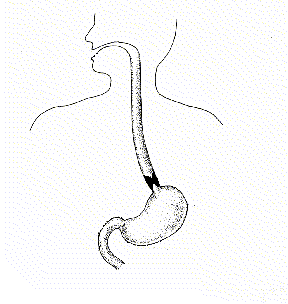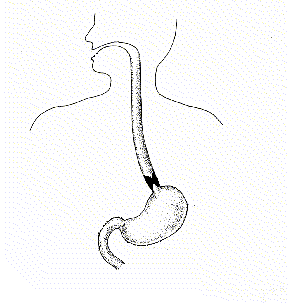Causes of GE Reflux
In almost all cases, gastroesophageal reflux is caused by incoordination or immaturity of the upper part of the intestinal tract. Before we can understand why reflux occurs, we need to understand how the upper part of the intestinal tract works.
 The 3 main parts of the upper intestinal tract are:
The 3 main parts of the upper intestinal tract are:
- esophagus
- stomach
- duodenum
The esophagus is a long muscular tube connecting your mouth and stomach. Muscles at the top and bottom of the esophagus control things coming and going, much like control valves. These are called the upper and lower esophageal sphincters (pronounced sfink – ters).
The stomach is hollow and surrounded by two very thick layers of muscle. It functions as a reservoir or holding tank for the food we eat. In children, when the stomach is empty, it is about the size of a fist, but it can get much bigger as it fills.
The duodenum is the uppermost part of the small intestine. The small intestine is a very long tube where food gets broken into very tiny “microscopic” particles that are then absorbed into the blood.
How do things work normally?
 When things are working normally, after chewing your food, you swallow. When you swallow, you are pushing food into the back of your throat and down your esophagus. At the bottom of the esophagus is the lower esophageal sphincter – the muscle that works to keep food in the stomach when the stomach is contracting or squeezing.
When things are working normally, after chewing your food, you swallow. When you swallow, you are pushing food into the back of your throat and down your esophagus. At the bottom of the esophagus is the lower esophageal sphincter – the muscle that works to keep food in the stomach when the stomach is contracting or squeezing.
When you swallow food, it doesn’t just fall down the esophagus, it is pushed down towards the stomach. The esophagus squeezes in a coordinated fashion with the squeeze moving from the top downwards towards the stomach (this coordinated type of squeezing is called peristalsis). As food reaches the bottom of the esophagus, the lower esophageal sphincter opens to let the food pass into the stomach and then it closes again. Every time we swallow food or saliva, our esophagus squeezes in this coordinated fashion and the lower esophageal sphincter temporarily opens.
Once food gets into the stomach, it mixes with stomach acid and other digestive juices. The stomach works like a blender, mixing and mashing food into very tiny pieces. Once the food is completely mashed, the muscle at the bottom of the stomach (the pylorus) opens and closes to very slowly dribble the food into the first part of the small intestine called the duodenum.
In the small intestine, the mashed food is broken into very tiny microscopic pieces by other digestive juices and then the “digested” food is absorbed . . . passed across the lining of the intestine and into the blood.
What happens with GE Reflux?
 As you can see, this is a complicated process. In children with GE reflux, some incoordination of the upper intestinal tract accounts for their problems. Most children with reflux are good eaters . . . in fact, many times they are guzzlers . . . when they are hungry, they cannot be put off. They often become frantic, screaming and clawing at their faces. Once they are fed, they tend to gulp down their milk or formula very quickly. They usually don’t choke or gag during feedings. This suggests they have no difficulty getting the food from their mouth to their esophagus!
As you can see, this is a complicated process. In children with GE reflux, some incoordination of the upper intestinal tract accounts for their problems. Most children with reflux are good eaters . . . in fact, many times they are guzzlers . . . when they are hungry, they cannot be put off. They often become frantic, screaming and clawing at their faces. Once they are fed, they tend to gulp down their milk or formula very quickly. They usually don’t choke or gag during feedings. This suggests they have no difficulty getting the food from their mouth to their esophagus!
Once the food is in their stomach, the stomach begins contracting – mashing and mixing it. In children with reflux, out of the blue, the lower-esophageal sphincter opens so that as the stomach squeezes, there is nothing to keep the food in the stomach and so it comes back up the esophagus. This is gastroesophageal reflux! Sometimes, the food and acid come all the way up the esophagus and out the mouth and the child “spits up” or “vomits”. Other times, the food or acid may only come part way up. In adults we call this heartburn or indigestion.
Anything that increases the pressure in the stomach has a tendency to make reflux worse. This is why many infants with reflux will spit up when they are straining to pass a bowel movement or when they cough, sneeze, or laugh.
Since reflux usually takes place when the stomach is contracting normally, most of the time when an infant “throws-up” or “spits-up” they don’t have much pain or discomfort. In fact, many infants with reflux are not bothered at all by their reflux and will be perfectly content immediately before they throw-up, and seem fine immediately afterwards too. Much of the time, it seems as if the baby isn’t aware of any problem before they throw-up! This is very different than when we vomit because we have an intestinal flu-virus or an intestinal blockage. With that type of vomiting, we feel sick beforehand. We become very nauseous and start sweating, salivating, and swallowing. We do all sorts of things to prepare ourselves for the vomiting including running to the bathroom!
